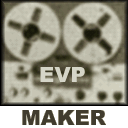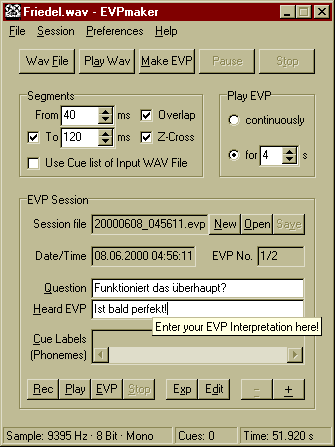|
EVPmaker |
|
|
EVPmaker is a free software program for the generation of acoustic "raw material" for recordings of paranormal tape voices, also known as "Electronic Voice Phenomena" (EVP), using the means of random controlled phoneme synthesis. EVP are recordings of utterances upon sound recording media (recorder tapes, cassettes, video tapes, etc.) which are physically unexplainable. These voices are often reasonable messages replying to corresponding questions, or they are referring to circumstances concerning the experimenter. More information about this topic can be found on the Web site of VTF, the German Association For Transcommunication Research or AA-EVP, the American Association Electronic Voice Phenomena. To generate the "raw material", EVPmaker uses a method called random controlled phoneme synthesis. In the simplest case, an audio file is being subdivided into short segments which then is played back in randomly order. With the use of a suitable sound editor with "cue list" feature, also "real" phonemes can be created and used in EVPmaker. These phonemes can then be logged during the random controlled playback together with their phonetic subscription symbols, so if you hear an EVP, you can also read its phonetic transcription. Moreover, EVPmaker offers the possibility to record "EVP Sessions". An EVP session can consist of any number of individual EVP. Each EVP is automatically provided with the current date and time. For each EVP a question and an interpretation can be entered. EVP sessions can be saved to disk and loaded again later. The raw material sequence of each EVP can be repeated as often as you wish, it can be saved as a WAV file, or it can be loaded into an sound editor where it can be processed or examined in any way. Every single raw material segment, from which the randomly generated sequence has been composed of, is stored in a "cue list". If the sound editor is able to display such a cue list, then these segments can be addressed and played back directly. In this way you can examine exactly, from which fragments a voice is composed of.
|
|

